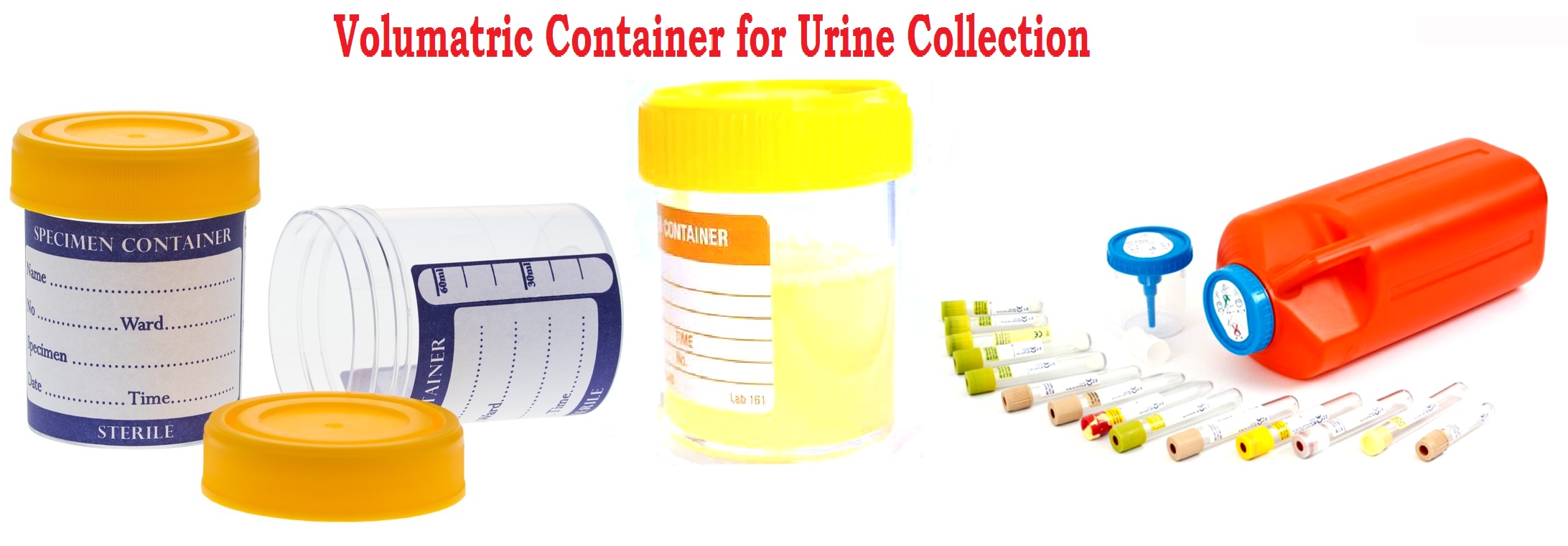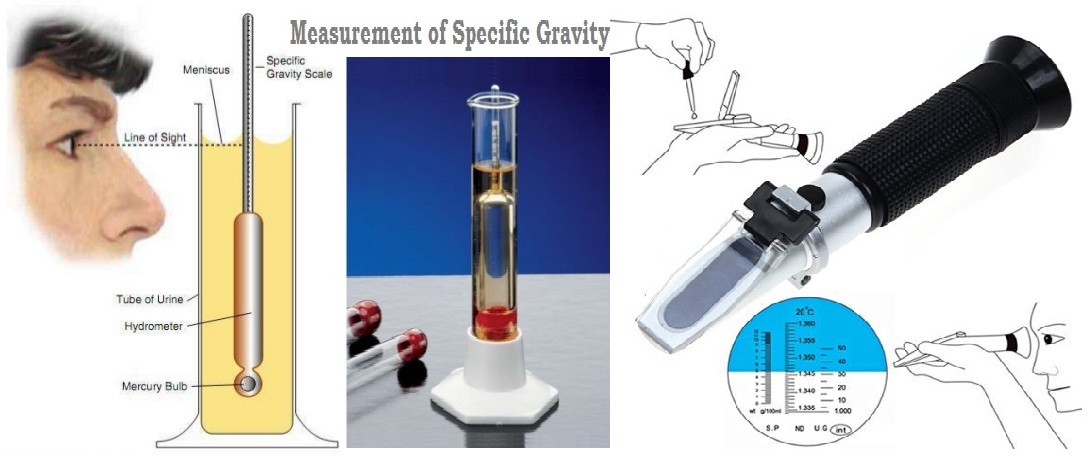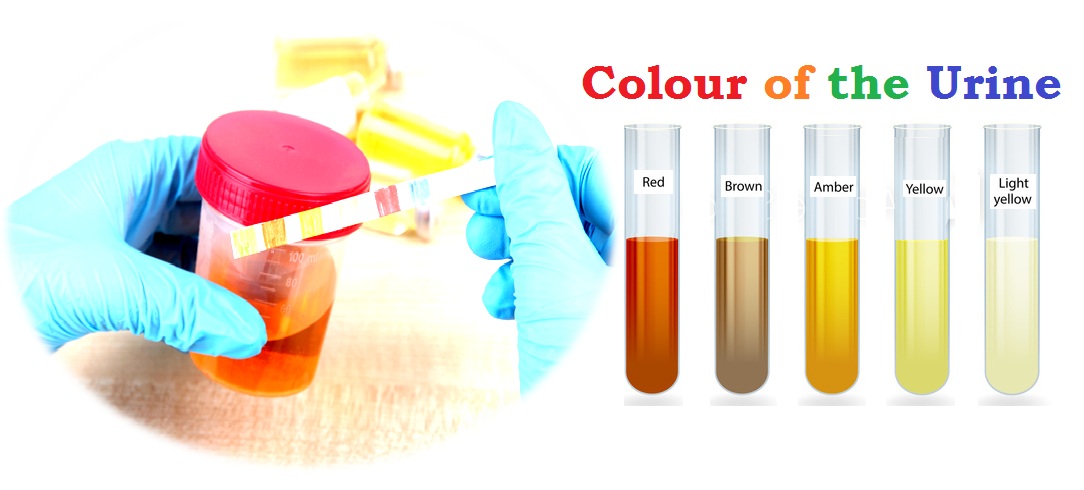Physical Examination of Urine
Routine examination of urine is consisting of mainly three examinations; Physical examination of urine, Microscopic examination of urine & Chemical examination of Urine. The physical tests measure the colour, transparency (clarity), and specific gravity of a urine sample. In some cases, the volume (daily output) may be measured. Color and transparency are determined from visual observation of the sample.
VOLUME
Normally urine is excreted about 1500 ml – 1800 ml per 24 hours by an adult. Urinary volume is dependent upon fluid intake; amount of solutes to be excreted, primarily sodium and urea; loss of body fluids by normal processes, such as perspiration and respiration, and abnormal processes, such as diarrhea; and cardiovascular and renal function. Although the volume of a random specimen is clinically insignificant, the volume of specimen received should be recorded for purposes of documentation and standardization. Urine volumes can be measured two ways: volumetrically and gravimetrically. That is, the volume is measured with a volumetric cylinder.
COLOUR
Normal urine is straw yellow to amber in color. Abnormal colors include bright yellow, brown, black (gray), red, and green. These pigments may result from medications, dietary sources, or diseases. For example, red urine may be caused by blood or hemoglobin, beets, medications, and some porphyrias. Black-gray urine may result from melanin (melanoma) or homogentisic acid (alkaptonuria, a result of a metabolic disorder). Bright yellow urine may be caused by bilirubin (a bile pigment). Green urine may be caused by biliverdin or certain medications. Orange urine may be caused by some medications or excessive urobilinogen (chemical relatives of urobilinogen). Brown urine may be caused by excessive amounts of prophobilin or urobilin (a chemical produced in the intestines).
APPEARANCE
Normally freshly voided urine is clear. When urine is allowed to stand, amorphous crystals, usually urates may precipitate and cause urine to be cloudy. The turbidity of urine should always be recorded and microscopically explained. Turbid (cloudy) urine may be caused by either normal or abnormal processes. Normal conditions giving rise to turbid urine include precipitation of crystals, mucus, or vaginal discharge. Abnormal causes of turbidity include the presence of blood cells, yeast, and bacteria.
SPECIFIC GRAVITY
The specific gravity of urine is a measure of the concentration of dissolved solutes (substances in a solution), and it reflects the ability of the kidneys to concentrate the urine (conserve water). Specific gravity is usually measured by determining the refractive index of a urine sample (refractometry) or by chemical analysis. Specific gravity varies with fluid and solute intake. It will be increased (above 1.035) in persons with diabetes mellitus and persons taking large amounts of medication. It will also be increased after radiologic studies of the kidney owing to the excretion of x ray contrast dye. Consistently low specific gravity (1.003 or less) is seen in persons with diabetes insipidus. In renal (kidney) failure, the specific gravity remains equal to that of blood plasma (1.008–1.010) regardless of changes in the patient's salt and water intake. Urine volume below 400 mL per day is considered oliguria (low urine production), and may occur in persons who are dehydrated and those with some kidney diseases. A volume in excess of 2 liters (slightly more than 2 quarts) per day is considered polyuria (excessive urine production); it is common in persons with diabetes mellitus and diabetes insipidus.
METHOD :
Urinometer method
PRINCIPLE :
The uniometer method of measuring specific gravity of urine is based on the principle of buoyancy. An increased solute concentration or specific gravity increases in the upthrust of the solution correspondingly increases. The increased upthrust is reflected by the scale of the urinometer as the latter is pushed up.
REQUIREMENTS:
- Urinometer
- Measuring cylinder.
SPECIMEN :
Suitable amount of urine. If the specimen quantity is small, dilute urine (1:5, 1:10). Determine specific gravity by Urinometer. Multiply the last two numbers of the recorded specific gravity by the diluting factor (5 or 10) and get correct specific gravity.
PROCEDURE :
- Mixed the urine and poured into the cylinder (25 ml capacity) provided by the manufacturer (3/4 part of the cylinder),
- Floated the Urinometer in the urine. Rotate it carefully so that it can be prevented from touching the bottom or sides of the cylinder and also formation of air buble.
- Read the specific gravity as soon as the Urinometer comes to rest. Taken the reading from the graduation given on the stem at the lower point of the meniscus formed by the water surface, and give the result.
NORMAL VALUE :
- Random : 1.003 – 1.035
- 24 hrs : 1.015 – 1.030








I used to be very happy to seek out this internet-site.I wished to thanks to your time for this wonderful read!! I positively having fun with each little bit of it and I’ve you bookmarked to check out new stuff you blog post.
This article is a source of inspiration, I recommend it.
Thanks and keep it up!
Hello, your post is so good.Following your posts.Keep writing….
Helo, I’ve been reading your site for a while now and finally got the bravery to go ahead. Just wanted to say keep up the great work! many thanks